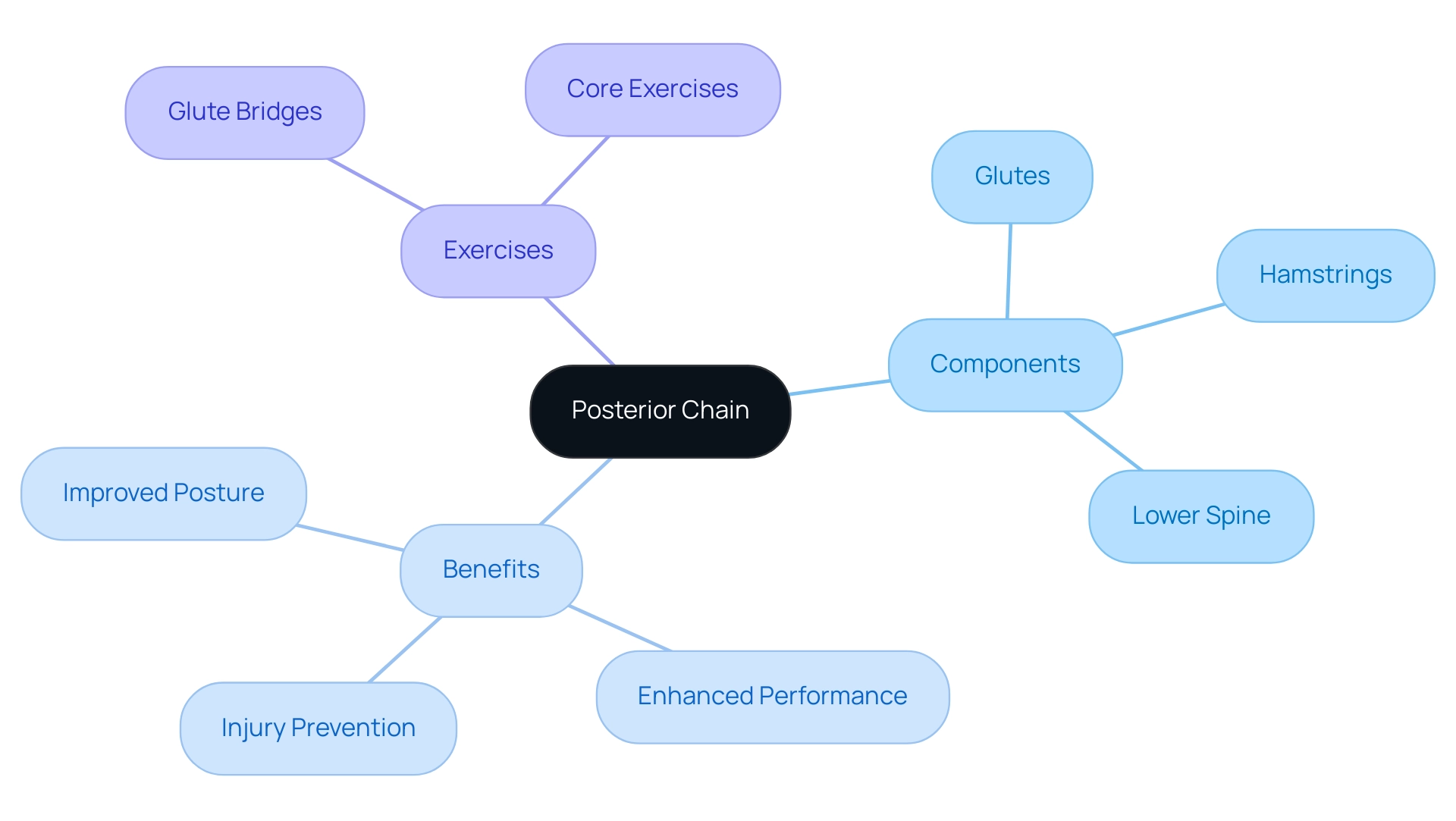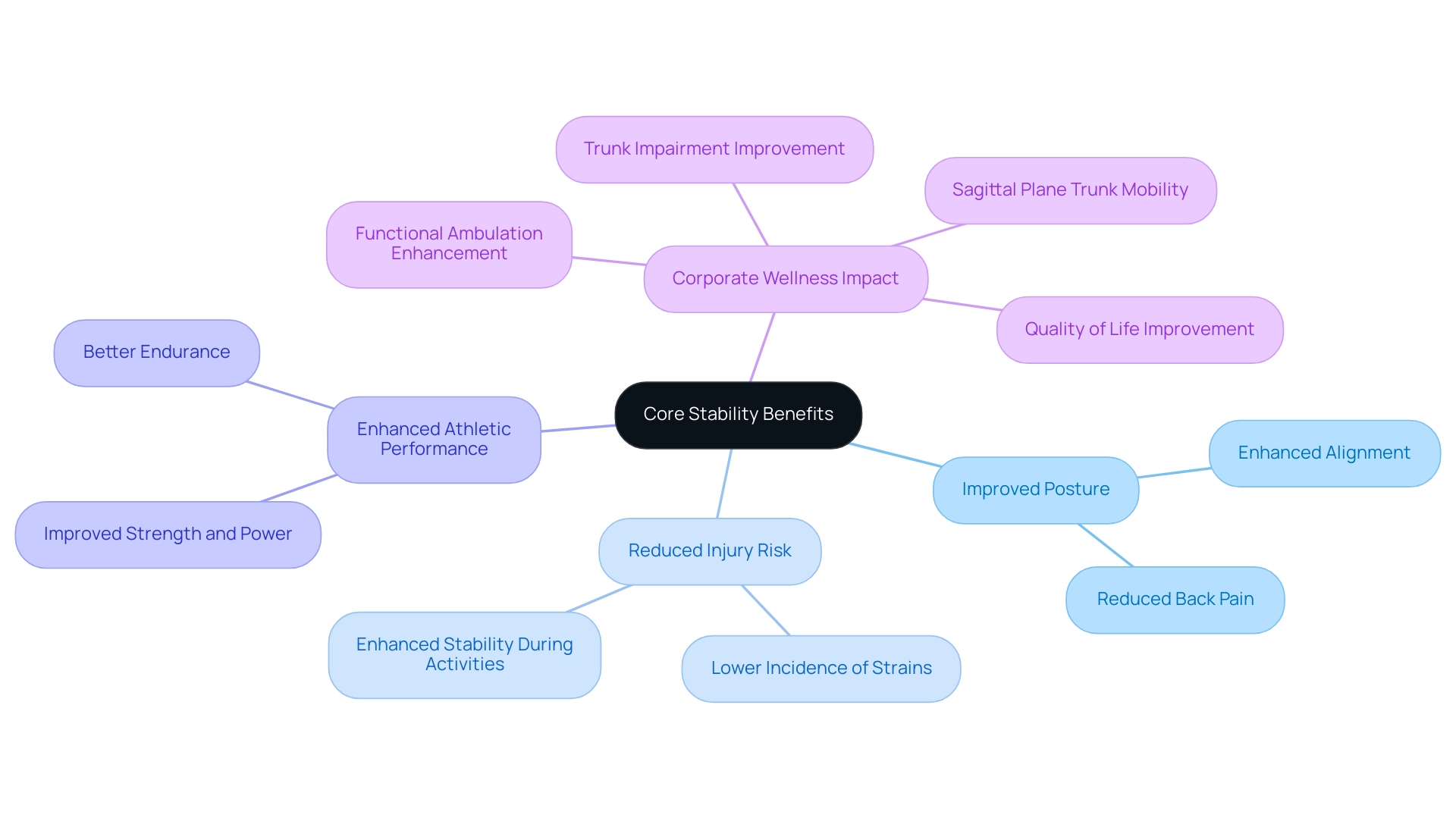Overview
The article provides a comprehensive step-by-step guide on performing posterior core exercises, emphasizing their importance for enhancing athletic performance and preventing injuries. It details specific exercises like deadlifts, glute bridges, and bird-dogs while highlighting the necessity of proper form and warm-up routines to maximize effectiveness and safety, supported by research on their benefits for core stability and overall physical well-being.
Introduction
The posterior chain is more than just a collection of muscles; it is the backbone of athletic performance and overall well-being. Comprising the glutes, hamstrings, and lower back, this powerful group plays a vital role in maintaining proper posture, enhancing strength, and preventing injuries.
As organizations increasingly recognize the importance of employee health, prioritizing posterior chain training can lead to significant benefits both in and out of the workplace. From improved athletic capabilities to reduced risk of chronic pain, the advantages of focusing on these muscle groups are compelling.
As HR Benefits Managers explore ways to foster a healthier workforce, understanding and implementing posterior chain exercises can be a game-changer, paving the way for a more dynamic and productive environment.
Understanding the Posterior Chain: Importance and Benefits
The posterior chain is an essential collection of tissues situated along the rear of your body, including the glutes, hamstrings, and lower spine. These muscles play a crucial role in maintaining proper posture, enhancing athletic performance, and preventing harm. By focusing on strengthening the posterior chain, individuals can significantly improve their balance and power during physical activities, which in turn reduces the risk of lower back pain.
Balanced training helps maintain proper alignment and movement mechanics, further reducing the risk of overuse injuries. The American College of Sports Medicine highlights the value of exercises targeting these areas, noting that,
This move is known for specifically targeting the hamstrings and glutes.
Moreover, recent studies advocate for a structured approach, suggesting that clinicians should prescribe a 12-16 week program centered around posterior chain rehabilitation to maximize improvements in pain relief and strength, particularly for those with chronic lower back pain (CLBP).
For example, glute bridges are effective for isolating and strengthening the glute muscles, crucial for improving hip extension power necessary for sprinting and jumping. Studies indicate that glute bridges effectively engage the gluteus maximus, rendering them a valuable activity for athletes aiming to improve posterior chain strength. Incorporating posterior core exercises is not just beneficial for physical well-being; it also enhances productivity and athletic performance.
As athletes increasingly recognize the importance of posterior core exercises for optimal performance in their respective sports, HR Benefits Managers should consider the positive impact of prioritizing these exercises as an essential component of any comprehensive fitness regimen.

Step-by-Step Guide to Effective Posterior Core Exercises
-
Deadlifts: Position your feet shoulder-width apart, grasping a barbell or dumbbells in front of your thighs. Engage your core, bend at your hips and knees while keeping your back straight, and lower the weights with control. Focus on driving through your heels as you return to a standing position. Aim for 3 sets of 8-12 reps of posterior core exercises to strengthen your posterior chain. Research indicates that intense deadlifting not only activates major tissue groups but also stimulates the release of anabolic hormones like testosterone and human growth hormone, enhancing your overall workout effectiveness. Notably, the concentric phase of the deadlift shows greater activation than the eccentric phase, underscoring its effectiveness in engagement. A study by Escamilla et al. (2002) discovered that traditional deadlifts led to increased activation of the vastus medialis and vastus lateralis, showcasing the activity's effect on various groups.
-
Glute Bridges: Lie flat on your posterior with your knees bent and feet flat on the ground. Press through your heels to lift your hips towards the ceiling, squeezing your glutes at the peak of the movement. Lower your hips back down and repeat for 3 sets of 10-15 repetitions. Research indicates that glute bridges significantly activate the gluteal tissues, making them an effective activity for enhancing athletic performance. A fitness trainer noted,
Glute bridges are a fantastic way to build strength in the posterior chain and are among the best posterior core exercises to prevent injury.
This activity, particularly posterior core exercises, plays a crucial role in maintaining strength, which is vital in preventing sarcopenia as we age.
-
Supermans: Lie face down on the floor with your arms extended in front of you. Lift your arms, chest, and legs off the ground simultaneously, holding for a moment before descending. Complete 3 sets of 10-12 reps. This activity encourages strength balance and stability, essential for avoiding lower spine discomfort.
-
Bird-Dogs: Begin on all fours with your hands positioned under your shoulders and knees under your hips. Extend your right arm forward and your left leg back, ensuring your spine remains neutral. Return to the start and switch sides, performing 3 sets of 8-10 reps on each side. This movement not only strengthens your core but also enhances coordination and balance. Machowsky emphasizes that maintaining muscle through activities like these is vital in preventing sarcopenia, especially as we age. Incorporating these exercises into your routine can lead to improved strength and rehabilitation outcomes.

Common Mistakes to Avoid and Tips for Success
- Neglecting Form: Prioritizing proper form is crucial for preventing harm while lifting. As highlighted by fitness experts, poor technique can lead to long-term damage. In fact, a study by Brown and Kimball estimated an incident rate of 0.29 per 100 participant hours in adolescent powerlifters, underscoring the importance of executing movements correctly. To ensure you're performing movements accurately, consider using a mirror or recording your workouts. This small step can help you refine your form and build confidence in your technique.
- Rushing Through Reps: It's essential to take your time with each repetition. Controlled movements not only enhance physical engagement but also considerably decrease the likelihood of harm. By slowing down and focusing on the quality of your movements, you can achieve better results and maintain your safety.
- Skipping Warm-Up: Warming up is a non-negotiable part of any workout routine. Participating in basic dynamic stretches readies your tissues and joints for the requirements of physical activity, improving performance and minimizing the chance of harm. This foundational step sets the tone for a successful workout.
- Ignoring Pain: Listening to your body is paramount. If you experience pain—distinct from normal muscle fatigue—it's crucial to stop and evaluate your form or consult a fitness professional. Disregarding these signals can result in severe harm, as demonstrated by the concerning rates of damage linked to improper physical activity techniques, especially in youth strength training. A D Faigenbaum highlighted that comprehensive conditioning programs created and overseen by qualified professionals are effective strategies for minimizing sports-related harm in young athletes. Additionally, ongoing public and medical concerns about the safety of youth resistance training, as highlighted in the case study titled "Concerns Regarding Safety of Youth Resistance Training," reinforce the necessity of proper training recommendations and awareness of risk factors. Remember, safety comes first, and taking proactive measures will ensure long-term success in your fitness journey.

Enhancing Core Stability Through Posterior Exercises
Incorporating posterior core exercises such as the bird dog and side plank into your regimen is essential for improving core stability, a fundamental aspect of functional movement in daily life. A robust core is synonymous with better posture, reduced injury risk, and heightened athletic performance. Recent findings emphasize that corporate wellness programs concentrating on core stability activities (CSE) have shown statistically significant enhancements in:
- Trunk impairment
- Functional ambulation
- Quality of life
- Sagittal plane trunk mobility
with a p-value of less than 0.05.
This evidence aligns with insights from sports scientists like Zachary Smrcina, who stated, 'Based on the results of this systematic review, there is grade B evidence to support the use and efficacy of using CSE to decrease symptoms and improve patient function in patients with acute NSLBP.' Furthermore, a case study on conventional physical therapy for stroke rehabilitation revealed that while the control group showed improvements, those participating in core stability training experienced even greater benefits. By emphasizing posterior core exercises, you not only fortify the back and glutes but also cultivate a balanced and resilient core.
The benefits of core stability extend beyond athleticism; they enhance performance in daily tasks and contribute to a healthier, more productive work environment. As HR Benefits Managers, investing in core stability training as part of your corporate wellness strategy stands as a proactive approach to injury prevention and peak employee performance. Additionally, our programs offer personalized attention and support from dedicated health coaches, ensuring that each employee receives guidance tailored to their specific needs.
By investing in preventive care, your organization can also realize significant cost savings, further enhancing the value of your corporate wellness initiatives.

Conclusion
Focusing on the posterior chain is not just about enhancing athletic performance; it's a crucial investment in overall health and well-being. These muscles—glutes, hamstrings, and lower back—are integral to maintaining proper posture, preventing injuries, and boosting functional movement. By prioritizing posterior chain exercises, organizations can foster a healthier workforce, reduce the risk of chronic pain, and enhance productivity.
Implementing effective exercises like:
- Deadlifts
- Glute bridges
- Bird-dogs
can significantly strengthen these muscle groups, leading to improved balance and power in physical activities. However, it's essential to approach these exercises with proper form and a focus on quality over quantity to maximize benefits and minimize the risk of injury. Incorporating warm-ups and listening to body signals are vital steps in ensuring a safe and effective training regimen.
Ultimately, investing in posterior chain training not only cultivates a more resilient and capable workforce but also aligns with broader organizational goals of health, productivity, and employee satisfaction. As HR Benefits Managers explore ways to enhance their corporate wellness programs, the integration of posterior chain exercises stands out as a transformative strategy, paving the way for a healthier, more dynamic workplace. Now is the time to take action and prioritize this essential component of employee wellness for long-term success.
Frequently Asked Questions
What is the posterior chain?
The posterior chain is a collection of tissues located along the back of the body, including the glutes, hamstrings, and lower spine.
Why is the posterior chain important?
The posterior chain is crucial for maintaining proper posture, enhancing athletic performance, and preventing injuries. Strengthening these muscles can improve balance and power during physical activities and reduce the risk of lower back pain.
How does balanced training benefit the posterior chain?
Balanced training helps maintain proper alignment and movement mechanics, which reduces the risk of overuse injuries.
What does the American College of Sports Medicine say about exercises targeting the posterior chain?
The American College of Sports Medicine emphasizes the value of exercises that specifically target the hamstrings and glutes.
What is the recommended duration for a posterior chain rehabilitation program?
A structured approach suggests a 12-16 week program focused on posterior chain rehabilitation to maximize improvements in pain relief and strength, especially for individuals with chronic lower back pain (CLBP).
Can you give an example of an effective exercise for the posterior chain?
Glute bridges are an effective exercise for isolating and strengthening the glute muscles, which are essential for improving hip extension power necessary for activities like sprinting and jumping.
How do posterior core exercises impact athletic performance?
Incorporating posterior core exercises not only benefits physical well-being but also enhances productivity and athletic performance.
What should HR Benefits Managers consider regarding posterior chain exercises?
HR Benefits Managers should recognize the positive impact of prioritizing posterior chain exercises as a critical component of any comprehensive fitness regimen for athletes.

